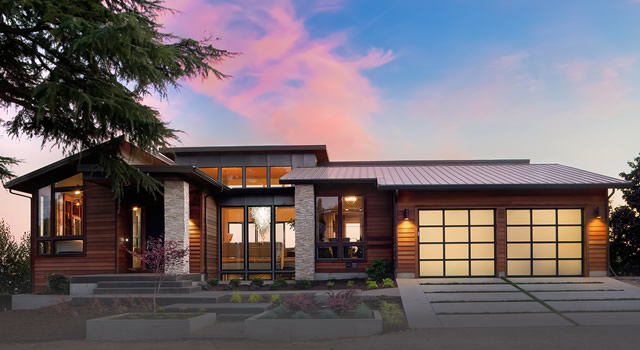

Do you like the existing look of your home, or do you want to redesign it completely? Siding can be used in both ways. You can quickly reproduce most exterior styles, or you can completely abandon the original look and start with a clean slate.
Unless you intend to stay in your home forever, you may want to consider how changes to your exterior affect your resale value. Anything that makes your home stand out from the surrounding homes can make a difference, both positively and negatively. The selections that you make will determine the look that you will end up with. Having an end vision in place before you begin to make your selections, makes the selection process easier and faster. Inspiration can come from many places: a house in your neighborhood that you like, a broader vision for your own house, or even something you saw on Instagram or your favorite DIY show.
Choosing the Right Siding
When selecting house siding (also known as cladding), there are six fundamental issues to consider, besides the initial cost:
- Water Resistance. Water-resistant types of siding have longer life spans.
- Ease of Installation. If you’re installing the siding on your own, make sure it is within your skill set, requires no special tools, and creates no harmful dust when cut.
- Energy Efficiency. Check the R-value rating for energy savings and understand what is needed as far as insulation beneath the siding you pick.
- Aesthetics. Your siding is in full view as you come and go, so make sure it is beautiful.
- Versatility. Make sure the siding has the versatility to meet the varied needs of your specific project. If there are aspects of your home’s exterior that make using a particular type of siding more challenging than others, be sure you understand what the added costs or necessary adjustments are.
- Durability. Does your siding of choice have the strength to resist temperature shifts present in your climate? How does it stand up to everyday wear and tear?
Fiberon Composite Cladding
You can get wood siding in long horizontal pieces or shaped to suit your individual design needs. That’s the beauty of choosing wood. You may want the look of clapboard – overlapping pieces of wood installed horizontally – or shingles – smaller pieces of wood overlapping like a shingled roof. Wood siding is a good choice for this façade.
It is strong and natural looking. While wood siding is available in a various colors (custom colors available to match your paint color-selection), we’d recommend choosing lighter shades over dark, to achieve a better expansion counter. That is, dark colors expand and contract more than light colors will with the weather.
Wood siding requires more maintenance than other siding options to keep it looking its best. It could initially be factory finished, or you could manually apply a clear sealer, paint, or a semi-transparent stain. Your choice of finish determines the maintenance schedule.
It’s recommended reapplying clear finishes every two to five years. Semi-transparent stains should be reapplied every three years, and using paint can stretch the timing from ten to fifteen years.
Raw unstained material and factory finishes are available. The higher cost of wood siding — from $8-12 per square foot — an incentive to maintain the investment.
Warranty varies from 5-50 years on color and wood decay.
Educational Series – Cladding
Do you like the existing look of your home, or do you want to redesign it completely? Siding can be used in both ways. You can quickly reproduce most exterior styles, or you can completely abandon the original look and start with a clean slate.
Unless you intend to stay in your home forever, you may want to consider how changes to your exterior affect your resale value. Anything that makes your home stand out from the surrounding homes can make a difference, both positively and negatively. The selections that you make will determine the look that you will end up with. Having an end vision in place before you begin to make your selections, makes the selection process easier and faster. Inspiration can come from many places: a house in your neighborhood that you like, a broader vision for your own house, or even something you saw on Instagram or your favorite DIY show.
Choosing the Right Siding
When selecting house siding (also known as cladding), there are six fundamental issues to consider, besides the initial cost:
- Water Resistance. Water-resistant types of siding have longer life spans.
- Ease of Installation. If you’re installing the siding on your own, make sure it is within your skill set, requires no special tools, and creates no harmful dust when cut.
- Energy Efficiency. Check the R-value rating for energy savings and understand what is needed as far as insulation beneath the siding you pick.
- Aesthetics. Your siding is in full view as you come and go, so make sure it is beautiful.
- Versatility. Make sure the siding has the versatility to meet the varied needs of your specific project. If there are aspects of your home’s exterior that make using a particular type of siding more challenging than others, be sure you understand what the added costs or necessary adjustments are.
- Durability. Does your siding of choice have the strength to resist temperature shifts present in your climate? How does it stand up to everyday wear and tear?
Fiberon Composite Cladding
You can get wood siding in long horizontal pieces or shaped to suit your individual design needs. That’s the beauty of choosing wood. You may want the look of clapboard – overlapping pieces of wood installed horizontally – or shingles – smaller pieces of wood overlapping like a shingled roof. Wood siding is a good choice for this façade.
It is strong and natural looking. While wood siding is available in a various colors (custom colors available to match your paint color-selection), we’d recommend choosing lighter shades over dark, to achieve a better expansion counter. That is, dark colors expand and contract more than light colors will with the weather.
Wood siding requires more maintenance than other siding options to keep it looking its best. It could initially be factory finished, or you could manually apply a clear sealer, paint, or a semi-transparent stain. Your choice of finish determines the maintenance schedule.
It’s recommended reapplying clear finishes every two to five years. Semi-transparent stains should be reapplied every three years, and using paint can stretch the timing from ten to fifteen years.
Raw unstained material and factory finishes are available. The higher cost of wood siding — from $8-12 per square foot — an incentive to maintain the investment.
Warranty varies from 5-50 years on color and wood decay.
Educational Series – Cladding

Customer Service
1-855-561-1114

Copyright 2023 Turkstra Lumber Company Ltd. | Privacy Policy | All Rights Reserved












